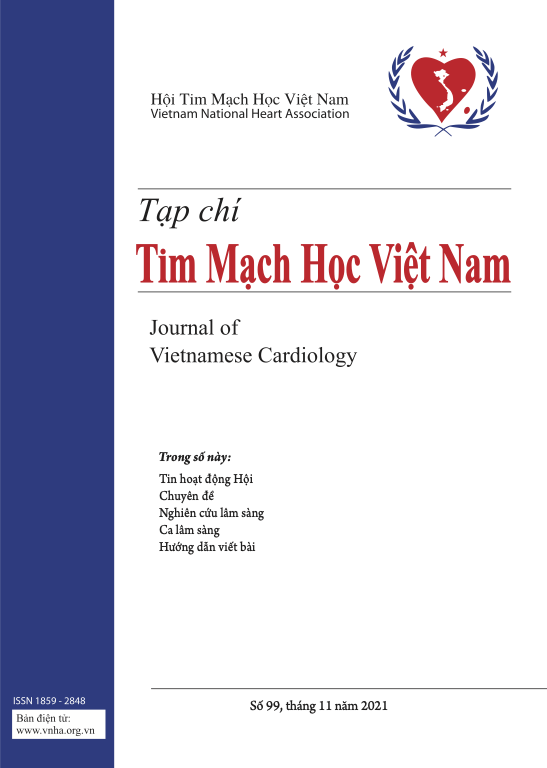Các yếu tố dự báo bệnh thân chung hoặc 3 nhánh mạch vành ở bệnh nhân hội chứng vành cấp không ST chênh lên
Tóm tắt
Cơ sở nghiên cứu: Xác định sớm bệnh thân chung hoặc 3 nhánh mạch vành là rất quan trọng ở các bệnh nhân hội chứng vành cấp (HCVC) không ST chênh lên vì việc dùng sớm aspirin và clopidogrel có thể làm tăng nguy cơ xuất huyết và tăng nhu cầu truyền máu ở các bệnh nhân phải phẫu thuật bắc cầu chủ vành sớm.
Mục tiêu: Xác định các yếu tố dự báo bệnh thân chung hoặc 3 nhánh mạch vành ở bệnh nhân HCVC không ST chênh lên tại Bệnh viện Đại học Y Dược TP. Hồ Chí Minh.
Phương pháp: Nghiên cứu cắt ngang. Những bệnh nhân vào viện vì đau thắt ngực điển hình kiểu mạch vành từ 01/2014 đến 04/2014 thỏa tiêu chuẩn chẩn đoán HCVC không ST chênh lên. Các bệnh nhân được chụp mạch vành trong thời gian nằm viện và chúng tôi so sánh các biến số lâm sàng và cận lâm sàng giữa hai nhóm có và không có bệnh thân chung hoặc 3 nhánh mạch vành để tìm ra yếu tố dự báo bệnh thân chung hoặc 3 nhánh mạch vành ở bệnh nhân HCVC không ST chênh lên.
Kết quả: Có 58 bệnh nhân thỏa tiêu chí vào nghiên cứu, 19 bệnh nhân (32,8%) bị bệnh thân chung hoặc 3 nhánh mạch vành. Phân tích đơn biến cho thấy có nhiều yếu tố có liên quan có ý nghĩa thống kê với bệnh thân chung hoặc 3 nhánh mạch vành. Khi phân tích đa biến, ST chênh lên ≥ 0,5 mm ở chuyển đạo aVR với OR = 17,03; KTC 95% [1,17 – 247,85]; p = 0,038 là yếu tố dự báo bệnh thân chung hoặc 3 nhánh mạch vành.
Kết luận: ST chênh lên ≥ 0,5 mm ở chuyển đạo aVR là yếu tố có giá trị trong dự báo bệnh thân chung hoặc 3 nhánh mạch vành ở các bệnh nhân HCVC không ST chênh lên.
Từ khóa: Phẫu thuật bắc cầu chủ vành, hội chứng vành cấp, bệnh thân chung hoặc 3 nhánh mạch vành.
Tài liệu tham khảo
1. Angiolillo, D.J., L.A. Guzman, and T.A. Bass, Current antiplatelet therapies: benefits and limitations. Am Heart J, 2008. 156(2 Suppl): p. S3-9.
![]()
2. Budaj, A., et al., Benefit of clopidogrel in patients with acute coronary syndromes without ST-segment elevation in various risk groups. Circulation, 2002. 106(13): p. 1622-6.
![]()
3. Anderson, J.L., et al., ACC/AHA 2007 guidelines for the management of patients with unstable angina/non ST-elevation myocardial infarction:Circulation, 2007. 116(7): p. e148-304.
![]()
4. Jneid, H., et al., 2012 ACCF/AHA focused update of the guideline for the management of patients with unstable angina/Non-ST-elevation myocardial infarction (updating the 2007 guideline and replacing the 2011 focused update): a report of the American College of Cardiology Foundation/American Heart Association Task Force on practice guidelines. Circulation, 2012. 126(7): p. 875-910.
![]()
5. Thygesen, K., et al., Third universal definition of myocardial infarction. Eur Heart J, 2012. 33(20): p. 2551-67.
![]()
6. Barrabes, J.A., et al., Prognostic value of lead aVR in patients with a first non-ST-segment elevation acute myocardial infarction. Circulation, 2003. 108(7): p. 814-9.
![]()
7. White, H.D., Higher sensitivity troponin levels in the community: What do they mean and how will the diagnosis of myocardial infarction be made? American Heart Journal, 2010. 159(6): p. 933-936.
![]()
8. Kosuge, M., et al., Combined prognostic utility of ST segment in lead aVR and troponin T on admission in non-ST-segment elevation acute coronary syndromes. Am J Cardiol, 2006. 97(3): p. 334-9.
![]()
9. Yamaji, H., et al., Prediction of acute left main coronary artery obstruction by 12-lead electrocardiography. ST segment elevation in lead aVR with less ST segment elevation in lead V(1). J Am Coll Cardiol, 2001. 38(5): p. 1348-54.
![]()
10. Kuhl, J.T. and R.M. Berg, Utility of lead aVR for identifying the culprit lesion in acute myocardial infarction.
![]()
Ann Noninvasive Electrocardiol, 2009. 14(3): p. 219-25.
![]()
11. Wong, C.K., et al., aVR ST elevation: an important but neglected sign in ST elevation acute myocardial infarction. Eur Heart J, 2010. 31(15): p. 1845-53.
![]()
12. Hamlin, R.L., et al., QRS alterations immediately following production of left ventricular free-wall ischemia in dogs. Am J Physiol, 1968. 215(5): p. 1032-40.
![]()
13. Holland, R.P. and H. Brooks, The QRS complex during myocardial ischemia. An experimental analysis in the porcine heart. J Clin Invest, 1976. 57(3): p. 541-50.
![]()
14. Cantor, A.A., B. Goldfarb, and R. Ilia, QRS prolongation: a sensitive marker of ischemia during percutaneous transluminal coronary angioplasty. Catheter Cardiovasc Interv, 2000. 50(2): p. 177-83.
![]()
15. Michaelides, A.P., et al., Effect of a number of coronary arteries significantly narrowed and status of intraventricular conduction on exercise-induced QRS prolongation in coronary artery disease. Am J Cardiol, 1992. 70(18): p. 1487-9.
![]()
16. Michaelides, A., et al., Exercise-induced QRS prolongation in patients with coronary artery disease: a marker of myocardial ischemia. Am Heart J, 1993. 126(6): p. 1320-5.
![]()
17. Michaelides, A.P., et al., QRS prolongation on the signal-averaged electrocardiogram versus ST-segment changes on the 12-lead electrocardiogram: which is the most sensitive electrocardiographic marker of myocardial ischemia? Clin Cardiol, 1999. 22(6): p. 403-8.
![]()
18. Cantor, A., et al., QRS prolongation measured by a new computerized method: a sensitive marker for detecting exercise-induced ischemia. Cardiology, 1997. 88(5): p. 446-52.
![]()
19. Murkofsky, R.L., et al., A prolonged QRS duration on surface electrocardiogram is a specific indicator of left ventricular dysfunction [see comment]. J Am Coll Cardiol, 1998. 32(2): p. 476-82.
![]()
20. Beigel, R., et al., Predictors of high-risk angiographic findings in patients with non-ST-segment elevation acute coronary syndrome. Catheter Cardiovasc Interv, 2013.
![]()








